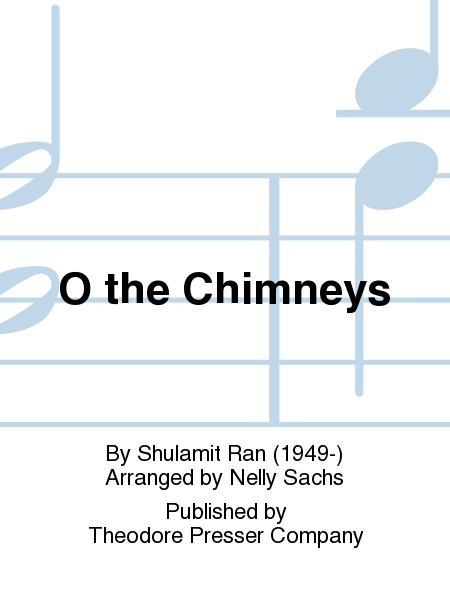O the Chimneys
for Mezzo-soprano Voice and Chamber Ensemble with Tape
-
Ships in 2 to 3 weeks
Details
Description
SKU: PR.111401800
For Mezzo-soprano Voice and Chamber Ensemble with Tape. Composed by Shulamit Ran. Arranged by Nelly Sachs. Text: Five Poems of Nelly Sachs, Translation from German of Nos. I, III and IV by Ruth and Matthew Mead, of No. II by Michael Roloff and No. V by Michael Hamburger. Contemporary. Set of Score and Parts. With Standard notation. Composed 1969. 51+16+14+20+14+15 pages. Duration 18 minutes. Theodore Presser Company #111-40180. Published by Theodore Presser Company (PR.111401800).UPC: 680160618132. 8.5 x 11 inches. Text: Nelly Sachs. Nelly Sachs. Text: Five Poems of Nelly Sachs, Translation from German of Nos. I, III and IV by Ruth and Matthew Mead, of No. II by Michael Roloff and No. V by Michael Hamburger.
O The Chimneys is a setting of five poems by Nelly Sachs, the great German-Jewish 1966 Nobel Prize co-winner in literature, whose writing concerned itself almost entirely with the subject of the holocaust. Composed in 1969, the work was my own personal way of saying, through my own art, do not forget. Shockingly, these words have as much relevance today as they did when the work was written. Today we find ourselves having to say do not forget, do not distort, do not deny it ever happened. I selected the five poems from Sachs' O The Chimneys collection, retaining its grimly evocative title even though I did not include the actual poem by that name. In scoring the work for female voice, flute, clarinet/bass clarinet, cello, piano and percussion, I aimed to give myself the broadest possible palette of instrumental colors while using the smallest number of participants. Yet as I was planning the final moments of my cycle, I felt that instrumental sound alone would not suffice to express the horror. An electronic tape segment was added to the work's final climax. The first two poems (A Dead Child Speaks and Already Embraced by the Arm of Heavenly Solace), both depicting the tearing of a child away from his mother, are treated essentially as one unit, with the first acting as an introduction to the second. These two, and the cycle's apocalyptic fifth poem (Hell is Naked from Glowing Enigmas II), act as the two weighty pillar points, so to speak, surrounding the more introspective two middle poems (Fleeing and Someone Comes). To maximize dramatic differentiation within the constraints of a relentlessly tragic subject matter, I used range as a means to delineate contrast, by dividing the sounds available to me into low and dark (mvt. III) vs. high and, at times, eerily bright (mvt. IV) colors. Thus the two middle poems are intended to balance the frenzied madness of which the work's outer parts are made. The work received its first performance in New York at the Metropolitan Museum of Art's Grace Rainey Auditorium on January 19, 1970. --Shulamit Ran.

 Share
Share